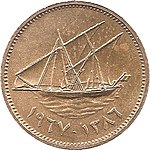| دينار كويتي (Arabic) | |
|---|---|
 1 Dinar banknote of Kuwait (sixth edition) 1 Dinar banknote of Kuwait (sixth edition) | |
| ISO 4217 | |
| Code | KWD (numeric: 414) |
| Subunit | 0.001 |
| Unit | |
| Symbol | د.ك or KD |
| Denominations | |
| Subunit | |
| 1⁄1,000 | fils |
| Banknotes | |
| Freq. used | KD 1⁄4, KD 1⁄2, KD 1, KD 5, KD 10, KD 20 |
| Coins | |
| Freq. used | 5, 10, 20, 50, 100 fulūs |
| Rarely used | 1 fils |
| Demographics | |
| Date of introduction | 1961 |
| User(s) | |
| Issuance | |
| Central bank | Central Bank of Kuwait |
| Website | www |
| Valuation | |
| Inflation | 1.50% |
| Source | The World Factbook, 2017 est. |
| Pegged with | Undisclosed currency basket $1 USD = 0.29963 KD |
The Kuwaiti dinar (Arabic: دينار كويتي, code: KWD) is the currency of Kuwait. It is sub-divided into 1,000 fulūs.
As of 2023, the Kuwaiti dinar is the currency with the highest value per base unit, with KD 1 equalling US$3.26, ahead of the Bahraini dinar with BD 1 equalling US$2.65 and Omani rial at US$2.60.
History
See also: British currency in the Middle EastThe dinar was introduced in 1961 to replace the Gulf rupee, equal to the Indian rupee. It was initially equivalent to £1 sterling. As the rupee was fixed at 1s.6d., that resulted in a conversion rate of Rs. 13+1⁄3 to KD 1.
When Iraq invaded Kuwait in 1990, the Iraqi dinar replaced the Kuwaiti dinar as the currency and large quantities of banknotes were stolen by the invading forces. After liberation, the Kuwaiti dinar was restored as the country's currency and a new banknote series was introduced, allowing the previous notes, including those stolen, to be demonetized.
Coins
The coins in the following table were introduced in 1961. The design of all coins is similar and has not changed since they were first minted. On the obverse is a boom ship, with year of minting in both Islamic and Common Era in Arabic. The reverse contains the value in Arabic within a central circle with الكُوَيت (Arabic for The Kuwait) above and KUWAIT in English below.
Unlike many other Middle Eastern currencies, Kuwait has a coin worth 0.02 of its main currency unit rather than 0.025 or 0.25 – though this latter does exist as a banknote (see below).
The 1 fils coin was last minted in 2014.
Banknotes
Six series of the Kuwaiti dinar banknote have been printed.
First series
The first series was issued following the pronouncement of the Kuwaiti Currency Law in 1960, which established the Kuwaiti Currency Board. This series was in circulation from 1 April 1961 to 1 February 1982 and consisted of denominations of KD 1⁄4, KD 1⁄2, KD 1, KD 5 and KD 10.
Second series
After the creation of the Central Bank of Kuwait in 1969 as a replacement to the Kuwaiti Currency Board, new KD 1⁄4, KD 1⁄2 and KD 10 notes were issued from 17 November 1970, followed by the new KD 1 and KD 5 notes of the second series on 20 April 1971. This second series was withdrawn on 1 February 1982.
Third series
The third series was issued on 20 February 1980, after the accession to the throne of late Emir Jaber Al-Ahmad Al-Sabah, in denominations of KD 1⁄4, KD 1⁄2, 1, 5 and KD 10. A KD 20 banknote was introduced later on 9 February 1986. As a result of the state of emergency after the Invasion of Kuwait, this series was ruled invalid with effect from 30 September 1991. Significant quantities of these notes were stolen by Iraqi forces and some had appeared on the international numismatic market. The "Standard Catalog of World Paper Money" (A. Pick, Krause Publications) lists notes with the following serial number prefix denominators as being among those stolen:
| Denomination | Prefix Denominators |
|---|---|
| KD 1⁄4 (د.ك١/٤) | 54–86 |
| KD 1⁄2 (د.ك١/٢) | 30–37 |
| KD 1 (١د.ك) | 47–53 |
| KD 5 (٥د.ك) | 18–20 |
| KD 10 (١٠د.ك) | 70–87 |
| KD 20 (٢٠د.ك) | 9–13 |
Fourth series
After the liberation, a fourth series was issued on 24 March 1991 with the aims of replacing the previous withdrawn series as quickly as possible and guaranteeing the country's swift economic recovery. This fourth series was legal tender until 16 February 1995. Denominations were KD 1⁄4, KD 1⁄2, KD 1, KD 5, KD 10 and KD 20.
Fifth series
The fifth series of Kuwaiti banknotes was in use from 3 April 1994 and included high-tech security measures which have now become standard for banknotes. It was withdrawn on 1 October 2015. Denominations were as in the fourth series.
| Fifth series Kuwait banknotes ("We Seek God's Assistance") | ||||
|---|---|---|---|---|
| Obverse | Reverse | Value | Obverse | Reverse |
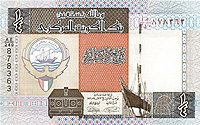
|
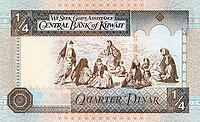
|
KD 1⁄4 | Coat of arms of Kuwait; Vignette of Kuwaiti Dhow "Al-Mouhaleb"; Vignette of a Kuwaiti Chest | Vignette of young girls playing traditional game |

|

|
KD 1⁄2 | Coat of arms of Kuwait; Vignette of Kuwaiti Money Changers' Stalls; Vignette of a Kuwaiti Coffee Pot | Vignette of young boys playing traditional game with marbles |

|

|
KD 1 | Coat of arms of Kuwait; Vignette of a traditional Oil Lamp; Vignette of Kuwait Towers | Vignette of Mina Al-Shuwaikh; Vignette of a traditional Water Storage Vessel on Stand |

|

|
KD 5 | Coat of arms of Kuwait; Vignette of the new telecom Tower 'Liberation Tower'; Vignette of a traditional Grinding Stone | Vignette of an Oil Refinery; Vignette of A’Zour Power Station; Vignette of Kuwaiti Water Tanks; Vignette of Electricity Pylons |

|

|
KD 10 | Coat of arms of Kuwait; Traditional water vessel; The state great Mosque | Fishermen; Vignette Dhow under full sail; A traditional Kuwaiti door; A pearl diving scene; Vignette of a Kuwaiti incense burner |

|

|
KD 20 | Coat of arms of Kuwait; Cannon; Red Fort at Jahra | Central Bank of Kuwait building; City gate of the old wall |
Sixth series
Central Bank of Kuwait brought the sixth series of Kuwaiti banknotes into circulation on 29 June 2014. Some of the notes are coarse so that the blind can identify them by touch.
| Sixth series Kuwaiti banknotes | |||||||
|---|---|---|---|---|---|---|---|
| Obverse | Reverse | Value | Dimensions (millimeters) | Color | Obverse | Reverse | Date of issue |

|

|
KD 1⁄4 | 110 x 68 mm | Brown | Liberation Tower and a dhow ship | A traditional wooden Kuwaiti door and the first Kuwaiti coin | June 29, 2014 |

|
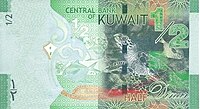
|
KD 1⁄2 | 120 x 68 mm | Green | Kuwait Towers and a dhow ship | Hawksbill sea turtle and the silver Pomfret fish (Al Zubadi) | June 29, 2014 |

|

|
KD 1 | 130 x 68 mm | Grey | The Grand Mosque, a bateel dhow ship | Illustration of many influences of Ancient Greek Civilization in Kuwait's Failaka Island | June 29, 2014 |
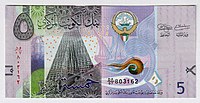
|

|
KD 5 | 140 x 68 mm | Purple | The new headquarters of the Central Bank of Kuwait | Oil refinery and an Oil Tanker | June 29, 2014 |

|

|
KD 10 | 150 x 68 mm | Pink | The National Assembly of Kuwait, a sambuk dhow ship | Falcon and camel dressed in a sadu saddle | June 29, 2014 |

|

|
KD 20 | 160 x 68 mm | Blue | Seif Palace, a dhow ship | Kuwaiti pearl diver and Al-Boom traditional Kuwaiti dhow ship | June 29, 2014 |
Commemorative issues
In both 1993 and 2001, the Central Bank of Kuwait issued commemorative KD 1 polymer banknotes to celebrate its Liberation from Iraq. The first commemorative note, dated 26 February 1993, was issued to celebrate the second anniversary of its Liberation. The front features the map of the State of Kuwait, the emblem of Kuwait and on the left and right side of the note is the list of nations that assisted in its Liberation, in both English and Arabic. The second commemorative note, dated 26 February 2001, was issued to celebrate the tenth anniversary of its Liberation. One feature from the note is an optically variable device (OVD) patch that shows a fingerprint, a reference to the victims of the invasion and occupation of Kuwait. Even though they were denominated as KD 1, both of the commemorative notes state that they were not legal tender.
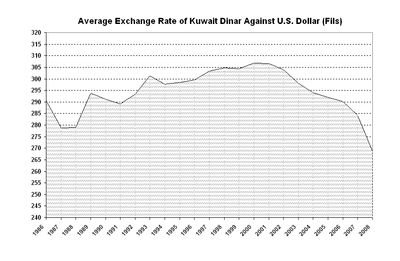
From 18 March 1975 to 4 January 2003, the dinar was pegged to a weighted currency basket. From 5 January 2003 until 20 May 2007, the pegging was switched to US$1 = KD 0.29963 with margins of ±3.5%. The central rate translates to approximately KD 1 = US$3.53.
From 16 June 2007, the Kuwaiti dinar was re-pegged to a basket of currencies, and was worth about $3.28 as of December 2016. It is the world's highest-valued currency unit.
| Current KWD exchange rates | |
|---|---|
| From Google Finance: | AUD CAD CHF CNY EUR GBP HKD JPY USD USD |
| From Yahoo! Finance: | AUD CAD CHF CNY EUR GBP HKD JPY USD USD |
| From XE.com: | AUD CAD CHF CNY EUR GBP HKD JPY USD USD |
| From OANDA: | AUD CAD CHF CNY EUR GBP HKD JPY USD USD |
See also
References
- "Exchange Rate Policy". www.cbk.gov.kw. Archived from the original on 28 December 2017. Retrieved 14 June 2016.
- ^ "New Kuwaiti banknotes due to appear on Sunday designed on bases of beauty, safety". KUNA. 28 June 2014. Archived from the original on 2 July 2014. Retrieved 6 July 2014.
- turkeytripguide.net. "Top 10 Strongest Currencies in the World 【2023】". turkeytripguide.net. Retrieved 9 January 2023.
- "KWD | Kuwaiti Dinar | OANDA". www1.oanda.com. Archived from the original on 24 November 2020. Retrieved 9 June 2020.
- ^ Hamza, Ali (23 August 2023). "History of Kuwaiti dinar and why it is the most valuable". Kuwait Times.
- Fineman, Mark (25 September 1990). "Iraq Tightens Control Over Kuwait, Outlaws Its Currency : Finance: Analysts say the move is certain to fail because the government-in-exile is still buying the nation's dinars". Los Angeles Times.
- Linzmayer, Owen (2012). "Kuwait". The Banknote Book. San Francisco, CA: www.BanknoteNews.com. Archived from the original on 23 September 2015. Retrieved 27 April 2012.
- ^ Ibn, Ifat (4 July 2011). "Friday Market Kuwait - Gulf Local Classifieds". Friday Market. Archived from the original on 29 March 2016. Retrieved 20 March 2016.
- "Arab Times -Leading English Daily in Kuwait". Archived from the original on 21 May 2014. Retrieved 21 May 2014.
- The Sixth Issue banknote series Archived 30 September 2014 at the Wayback Machine Central Bank of Kuwait (www.cbk.gov.kw). Retrieved on 2014-05-22.
- Kuwait 1 dinar commemorative banknote (1993) Archived 24 May 2013 at the Wayback Machine Banknote Museum (banknote.ws). Retrieved on 11 February 2013.
- Kuwait 1 dinar commemorative banknote (2001) Archived 24 May 2013 at the Wayback Machine Banknote Museum (banknote.ws). Retrieved on 11 February 2013.
- "Exchange Rates, Central Bank of Kuwait". Archived from the original on 3 January 2018. Retrieved 4 January 2008.
- "Kuwait pegs dinar to basket of currencies". Forbes. 20 May 2007. Archived from the original on 10 November 2007. Retrieved 6 June 2007.
- This article draws heavily on the corresponding article in the German Misplaced Pages, retrieved 2 March 2005.
External links
- Images and description of banknotes (New Central Bank of Kuwait website). Archived 7 December 2014 at the Wayback Machine.
- The banknotes of Kuwait (in English and German)
| Preceded by: Gulf rupee Ratio: 1 dinar = 131⁄3 rupees = 1 pound sterling |
Currency of Kuwait (pre-war) 1961 – August 2, 1990 |
Succeeded by: Iraqi dinar Reason: Iraqi invasion of Kuwait |
| Preceded by: Iraqi dinar Reason: liberation of Kuwait Ratio: = pre-war Kuwaiti dinar |
Currency of Kuwait (post-war) early 1991 – |
Succeeded by: Current |
| Kuwait articles | |||
|---|---|---|---|
| History |  | ||
| Geography | |||
| Politics | |||
| Economy | |||
| Culture | |||
| Currencies named dinar or similar | |
|---|---|
| Circulating | |
| Defunct | |
| As subunit | |
| See also |
|
| Currencies of Asia | |
|---|---|
| Central | |
| East | |
| North | |
| South | |
| Southeast | |
| West | |
